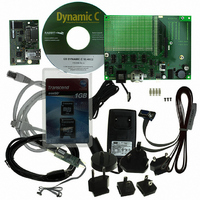101-1288 Rabbit Semiconductor, 101-1288 Datasheet - Page 4

101-1288
Manufacturer Part Number
101-1288
Description
KIT APPLICATION SIMPLE SENSOR
Manufacturer
Rabbit Semiconductor
Series
RabbitCore 4000r
Specifications of 101-1288
Mfg Application Notes
Simple Sensor App Kit, AppNote
Sensor Type
Temperature
Interface
1-Wire Serial
Voltage - Supply
12V
Embedded
Yes, Other
Utilized Ic / Part
RCM4300
Maximum Operating Temperature
+ 85 C
Minimum Operating Temperature
- 20 C
Lead Free Status / RoHS Status
Lead free / RoHS Compliant
Sensitivity
-
Sensing Range
-
Lead Free Status / Rohs Status
Lead free / RoHS Compliant
Other names
316-1178
Run a Sample Program
Once the RCM4300 is connected as described in the preceding pages, start Dynamic C by double-clicking on
the Dynamic C icon on your desktop or in your Start menu. Select Store Program in Flash on the “Com-
piler” tab in the Dynamic C Options > Project Options menu. Make sure that the Enable Separate
Instruction & Data Space option is checked. Then click on the “Communications” tab and verify that Use
USB to Serial Converter is selected to support the USB programming cable. Click OK.
You may have to select the COM port assigned to the USB programming cable on your PC. In Dynamic C,
select Options > Project Options, then select this COM port on the “Communications” tab, then click OK.
Use the File menu to open the sample program PONG.C, which is in the Dynamic C SAMPLES folder. Press
function key F9 to compile and run the program.The STDIO window will open on your PC and will display a
small square bouncing around in a box.
Where Do I Go From Here?
You are now ready to go on to other sample programs and to develop your own applications. Application
Note AN420, Simple Sensor Application Kit, takes you through loading and using the sample programs
included with this Application Kit, and describes Rabbit’s software drivers.
provides complete hardware reference information and describes the software function calls for the
RCM4300 RabbitCore modules. The FAT File System document on the Dynamic C CD describes the FAT
file system and discusses the function calls and sample programs available for the Dynamic C implemen-
tation of the FAT file system.
Troubleshooting
If Dynamic C cannot find the target system (error message "No Rabbit Processor Detected."):
•
•
•
•
Press <Ctrl-Y> to force Dynamic C to recompile the BIOS. You should receive a Bios compiled
successfully message once these steps are completed successfully.
If there are any other problems:
•
•
•
Check that the RCM4300 is powered correctly — the red PWR LED on the Prototyping Board should be lit
when the RCM4300 is mounted on the Prototyping Board and the AC adapter is plugged in.
Check both ends of the programming cable to ensure that they are firmly plugged into the PC and the
PROG connector, not the DIAG connector, is plugged in to the programming port on the RCM4300 with
the marked (colored) edge of the programming cable towards pin 1 of the programming header.
Ensure that the RCM4300 module is firmly and correctly installed in its socket on the Prototyping Board.
If a program compiles and loads, but then loses target communication before you can begin debugging, it is
possible that your PC cannot handle the default debugging baud rate. Locate the Serial Options dialog in
the Dynamic C Options > Project Options > Communications menu. Choose a lower debug baud
rate.
Use the Dynamic C Help menu to get further assistance with Dynamic C.
Check the Rabbit Technical Bulletin Board and forums at
and at
Use the Technical Support e-mail form at www.rabbit.com/support/.
NOTE: If you purchased your Simple Sensor Application Kit through a distributor or through a Rabbit
www.rabbit.com/forums/
partner, contact the distributor or partner first for technical support.
.
020–0154 • 090131–A
www.rabbit.com/support/bb/
T
he RCM4300 User's Manual

















